It may seem obvious to many of you, but surprisingly, I’ve met a lot of business owners that still do not realize it: influencer marketing is extremely effective. The main reason behind it is the fact that influencers’ audiences are genuinely loyal and tend to follow their advice.
In fact, 84% of web users trust online opinions and reviews as much as personal recommendations. This gives brands an outstanding opportunity to let their potential customers know of their existence.
Once the relationships with the influencers are established, brands can also benefit from using their social media channels to further promote their products. And if an influencer runs a personal blog, that leaves even more room for action.
Having a pool of trusted influencers spreading your brand message may be quite effective. Building it is a tricky task, but with a clever strategy, everything is possible. Let's take a look at how you can go about:
- How to find a perfect influencer to collaborate with
- Where to look for influencers
- How to connect with influencers and journalists
- Common mistakes - how NOT to reach out to influencers
- How to manage influencer contacts once you have them
- How to strengthen relationships with influencers
How to find a perfect influencer to collaborate with
Finding the right person is the first step of your journey. Influencers come in all shapes and sizes, and your primary goal should be to find the most suitable ones.
But before you even start looking, you have to understand who is your ideal influencer. What you must keep in mind is that your ultimate goal is not to make friends with a blogger, but to connect with their audience. Hence, you should make sure that it resonates with your business.
For instance, if you are a local business, there is not much sense in collaborating with a nationwide blogger whose readers come from all over the country. Chances are, none of them live anywhere nearby you. Or, if you are a big B2B company with a certain reputation, it might be not wise to work with a blogger who uses profanity or expresses radical opinions that may upset your core audience.
One thing to mention, though: beware of fake influencers. Yes, since the demand for influencer marketing is so big, some people make use of it creating fake profiles and making their living from it. Make sure you don’t fall into this trap.
Here are a couple of questions you should ask yourself when evaluating an influencer:
- How old is their profile?
- How close is their tone of voice to your brand’s?
- Could their audience be interested in your product or service?
- How often do they publish posts that are relevant to your business?
- How often do they promote other brands?
- Do their engagement metrics look natural?
Where to look for influencers
It might be obvious for those who have done similar research before, but if you’re new to this, I always recommend starting the hunt with quick keyword research. That is, putting together a list of keywords that are relevant to your niche.
This will give you an understanding of what kind of topics your target influencers should write about on their blogs and social media pages.
Once you know what kind of topics your “target influencers” should be writing about, it’s time to catch them all. Start by searching for posts that feature top experts within your niche. For instance, this post lists top social media influencers and this one gives you a list of top SEO experts. - Kevin Indig, Growth Memo
Another tip is to look for round-up posts: they always have a number of well-known personas to add to your list. My recent post about the best content marketing strategies would be a good example.
This brings us to the next point:
Use handy Google search operators
Searching for round-up posts and lists of experts doesn’t require too much time if you know how to use Google search operators. Let’s imagine you’re searching for content marketing experts. Here’s a list of search operators that you can use:
- Inurl:“best content marketing experts”
This operator will give a list of the pages that contain the term “best content marketing experts” in their URL.
- Intitle:“best content marketing experts”
With the help of this operator, you’ll get a list of URLs that contain the keyword “best content marketing experts” in their page title.
What’s important to mention is that there’s a big downside to those lists. Very often they feature people who are not very active online or even those who are not really influencers. That means you have to manually check every expert to make sure they can really help your brand be more visible.
Try BuzzSumo
To speed up the process of uncovering industry influencers, I use the BuzzSumo. It allows me to uncover content that is written by industry leaders on a specific topic.
Go to BuzzSumo and search for a term that is relevant to your niche. For instance, I’d love to connect with more fellow link builders. Just perform a search with ‘link building’ term and you will see a list of posts for a given time period. Different social media engagement stats come in particularly handy.
The best thing about utilizing BuzzSumo is that it allows me to export all results and see authors’ names in a separate column.
Another useful feature allows you to find all posts created by a certain person by using the “author: XXXX» parameter. It helps a lot because this way you can filter out those bloggers that did only a few posts versus those who do it on a regular basis:
Besides searching with terms relevant to your niche you can also review guest contributors that write on top-notch industry blogs. Below you can see a list of authors who published their articles on Search Engine Watch. Naturally, it is safe to presume that they are considered experts in their niche, and collaborating with them can help you a lot.
Top Authors is another feature that is handy. It helps you find the most effective influencers in a given niche. It's probably the quickest way to find bloggers who publish content that is relevant to you.
BuzzSumo’s algorithm can also allow you to look for influencers with a certain search term in their Twitter bio. For example, here’s a list of influencers with the term “link building” in their bio:
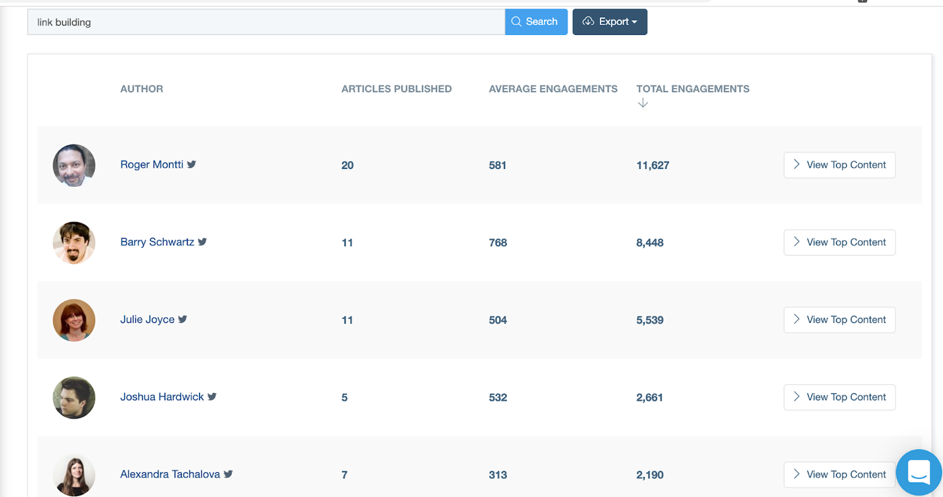
Find referring domains
Another way of finding influencers is by looking through your rivals’ referring domains. Among the pages that are linking to their site might be a good number of influencers'. To get access to a website’s referring domains you can use a variety of SEO tools like Semrush. Robbie Richards gives a great run-through in this traffic analysis guide.
The key is to focus on the Traffic Sources Details report:
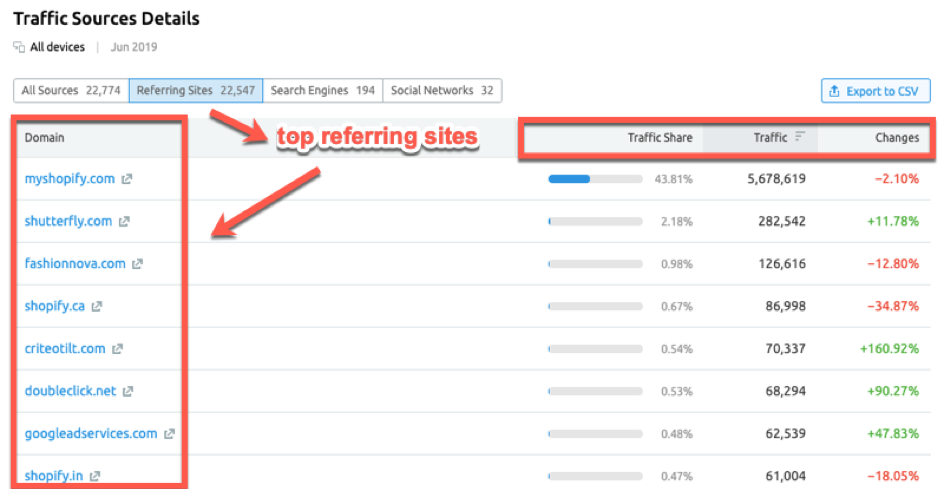
Once you have a list of sites driving a lot of referral traffic, click through and see how those sites are talking about the competition. Are they reviewing products/services? Do they have a partnership of some type? Are they mentioning competitors in an article that gets a lot of organic traffic each month?
These insights will dictate how you reach out and try to build a relationship with the influencer/owner of the site. The beauty of this approach is that it provides passive traffic every month.
Always make sure the traffic coming through those referral sources is relevant to your business, meaning the referral traffic will be interested in the products/services you sell.
Discover Twitter influencers
Finally, you can use tools like Followerwonk that allow you to search through Twitter bios and get the list of the most influential experts within your niche. To make sure no fake influencers appear in this list, Followerwonk uses the special Social Authority score that is based on engagement metrics.
While all the aforementioned tools and techniques are extremely helpful, please don’t forget that no tool can replace common sense. You still will have to handpick the bloggers to work with by manually checking their accounts and monitoring the way they interact with their audience.
Take advantage of a media database
A media database is a directory of various national or international media contacts, as well as digital influencers. With a quick search, tools like Prowly or Anewstip give you a massive list of influencers of all types, along with their contact details.
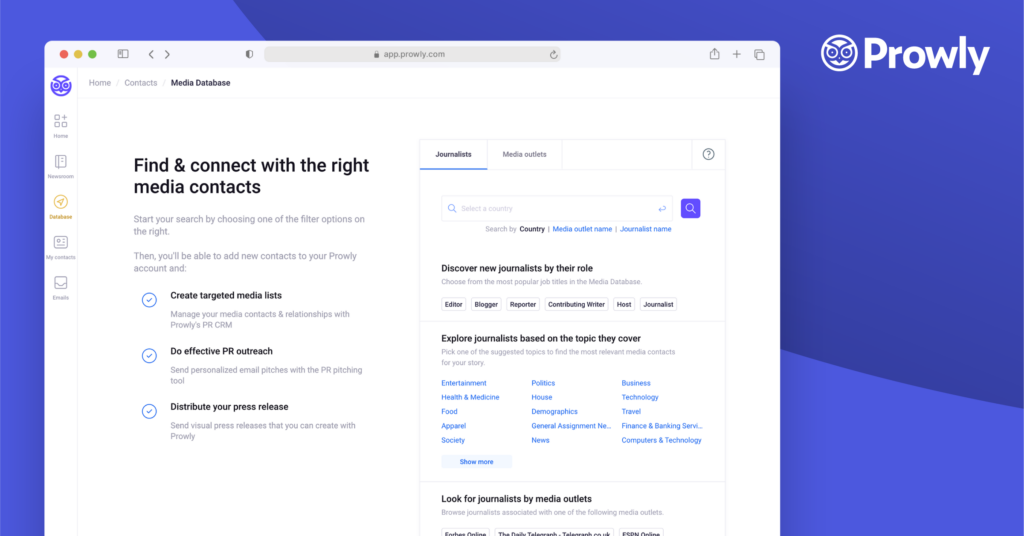
Once you pick the ones you want to collaborate with, the real work starts. It's time to reach out.
How to connect with influencers and journalists
You only get one chance to make a first impression. Don’t run it! Here are some tips to help you start off on a right foot with influencers:
Leverage social media
The best way to get in touch with influencers is to never “cold-pitch” them. Use social media for breaking the ice and making influencers familiar with my name before reaching out via email, and find out if you can help in some other way.
Once you're on their radar, it should be easier to build a relationship with them.
My preferred way to connect with influencers is finding a common connection in my network. It instantly makes strangers trust me as someone they know affirms that I'm a legit professional. - Chintan Zalani, Writer and Content Marketer @ Elite Content Marketer
Joining industry groups on social media is also one of the best strategies for quickly and easily building relationships with industry experts.
Once you're a part of a group, spend some time leaving meaningful comments and communicating with other members. After this, you can easily connect with group members by sending them a quick email and saying that you're also a part of XYZ group.
The chances that they will reply to you are pretty high, as having something in common (like being a member of one group) automatically makes you a trustworthy source. - Paul Granger, Website Promoter
Prove that you care
Before approaching an influencer, do your homework. You need to spend some time getting through their posts and writing up something meaningful.
Find their most recent content that was published on their own site and hasn’t exactly gone viral. To find such posts, you can go to BuzzSumo and search via an author’s name. For instance, here’s a list of posts that were written by me in the last few months.
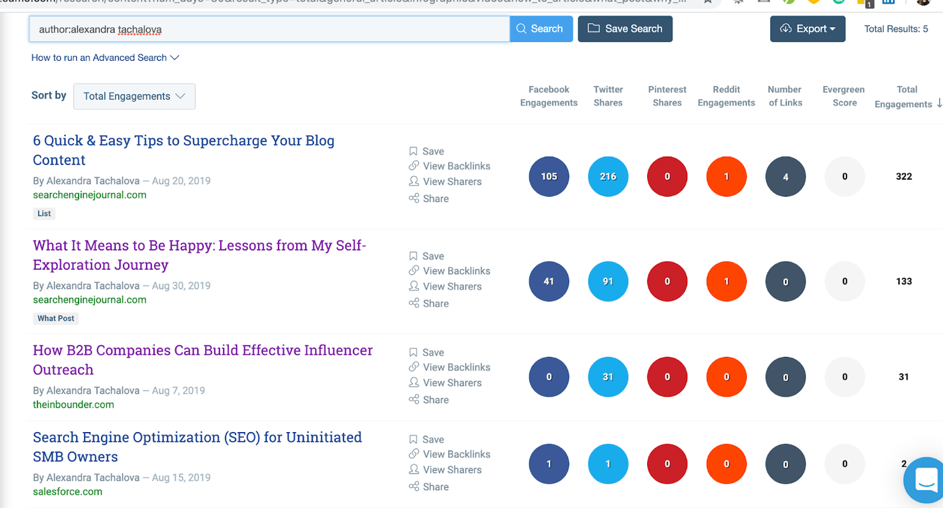
If you can, go the extra mile and share and/or link to the influencer’s content. This technique is completely free to use, and it could get some great results if your website has a solid domain authority, or there's an active social media following.
In an ideal world, each and every initial email has to be unique and custom-tailored for the recipient. Unfortunately, it is not always a realistic scenario, but you have to add at least a few sentences that will make it clear that your message was not delivered in a bulk - like most of the really bad pitches out there.
Don’t slow your pace
Once your conversation with an influencer starts, make it clear that you are interested in building a long-term relationship rather than taking advantage of quick wins.
For example, explain how exactly you could help them grow their brand. Among other options, you can keep promoting their posts across your SMM platforms, feature them in your newsletters, invite them to contribute to your most recent round-up post, or even leave a quick quote in your next guest post.
One of the best ways to give a great shout-out to experts is putting together a round-up post without even asking them to write anything up. Take a look at this article by Adzooma: they created a list of the most influential Google Ads experts, and voila!
If something goes wrong and your emails stop getting responses from an influencer, don’t panic. It does not necessarily mean that they do not want to cooperate with you anymore. Sometimes it is just impossible to keep track of all conversations. In this case, a finely-crafted follow-up email may come in handy.
Common mistakes - how NOT to reach out to influencers
There are myriads of ways to screw up the process of establishing a connection with industry experts. Here are a few of the most common ones:
Lack of personalization and using some dirty tricks
If you ever owned a website, I bet you were getting dozens of such emails on a daily basis. They are clearly sent out to thousands of recipients simultaneously, so probably they won’t even call you by name.
Dull, unimaginative, copy-and-pasted templates containing the same dusty old compliments. They ask you for a link, or permission to publish an article that contains a link, or just a mention… they are countless, they are annoying, and sending such email is the easiest way to get instantly blacklisted.
As for tricks, I added a screenshot below where I highlighted the “Sent from my iPhone” line. It really looks odd since the email was clearly part of a large-scale outreach campaign, and adding such misguiding lines does not do any good for a sender.
Asking for a favor without providing any value
Whether you want to ask someone for a link from their website or to share your super insightful article with their social followers, just asking is not enough. You must explain why you think it will provide value for their audience and how they can benefit from it.
If an influencer has never heard of you, they have literally zero reasons to do anything for you. Demanding something out of the blue is the best way to get ignored or (the worst possible scenario) made fun of.
Adding wrong value proposition
I often hear of this mistake being made by SaaS companies. Offering access to your product in exchange for favor may not be the most effective way of interacting with influencers. It has nothing to do with your product quality, it is about influencers’ needs.
Let’s say you develop a specialized CRM for catering companies. You know that there is a food blogger who is extremely popular among such companies owners. Does it mean that this blogger needs free access to your tool? Not at all.
Now that you have some contacts, let’s talk about influencer management.
How to manage influencer contacts
First things first, you need to set up some process to make things less messy and easily manageable. I recommend starting with getting rid of all spreadsheets if you use them for influencer management. Since growing the number of active contacts on a monthly basis should be your priority, this list may grow huge and get out of control pretty fast.
What you need is a tool that allows you to track all interactions with your industry experts that can be shared with other team members. It has to have some custom sorting options, for example, to create lists of the most and least active influencers.
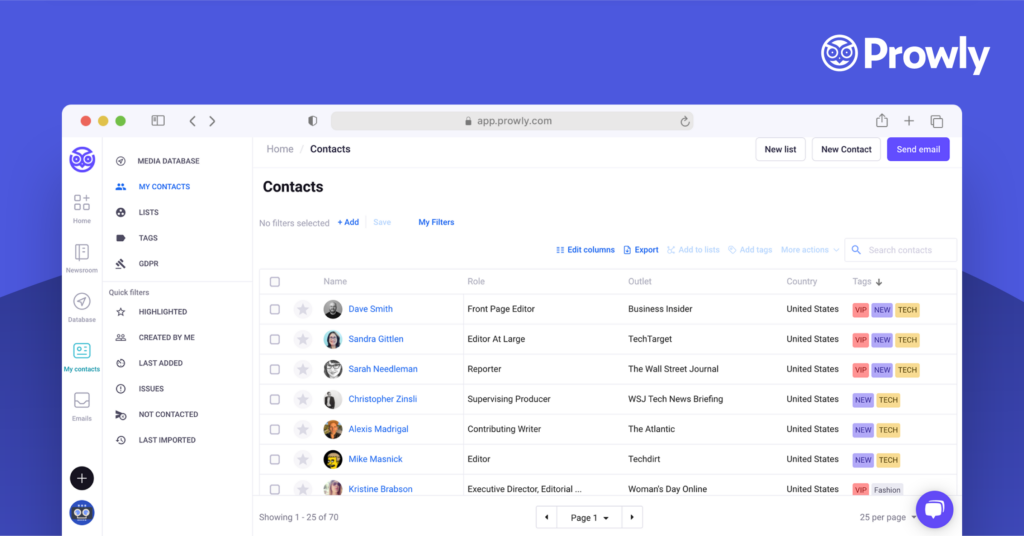
Once you have a proper tool, "classify" your influencers - find out how influential they really are and sort them accordingly.
Well-known experts are usually less responsive and probably won’t be interested in promoting your brand right away. You need to spend at least several months giving them enough reasons to collaborate with you.
Don't hurry up to chase for the so-called macro-influencers with millions of subscribers on social media. Although the number of followers may look persuasive enough to call someone an influencer, savvy marketers pay more attention to the relevance and engagement of the audience. - Lesley J Vos
That’s why you always need to maintain the right balance in your influencer portfolio having a mixture of the so-called rising stars and those with established personal brands. Experts with smaller following are usually more responsive as they’re looking for opportunities to empower their personal brand and increase their influence.
Additionally, it’s important to understand that those two groups have different mindsets and require a different approach. It makes sense to involve big influencers for major projects, while you can ask a micro-influencer for as much as a retweet.
Evaluating and diversifying your influencer portfolio is a must-do when it comes to promoting your physical or digital product(s). And it's an integral part of your growth marketing strategy. The evaluation process depends on your niche, but some key aspects you should consider are their engagement rate, follow-to-follower ratio, and previous brands/products they’ve promoted. - Nick Dimitriou, Head of Growth at Moosend
How to strengthen relationships with influencers
Some marketers think that the tough nut to crack is to connect with influencers. On the opposite, I think that it is the easiest part; the real job is to maintain those relationships and keep bringing value to your industry experts on a regular basis. Your goal is to turn them into brand ambassadors that are keen to promote your brand whenever it’s possible.
Need some more ideas on what to do once you have a loyal influencer by your side? The possibilities are countless, here are just a few of them.
Asking an influencer to contribute to your blog
Actually, that might not necessarily be a full-fledged guest post. You could ask an influencer to drop a quote for an article that you create. It will definitely help you promote your post once it’s live.
On the screenshot below taken from this article, you can see a quote from an expert which adds depth to the post and promotes an influencer at the same time.
Another option is a roundup post such as this one. It contains a mixture of expert answers and some additional information, also don’t forget about the importance of the visual appearance and usability of your post.
Inviting an influencer to host a webinar
The good thing about webinars is that they do not demand too many resources; while not every expert is ready to spend hours writing a blog post, preparing for a webinar is much quicker. Also, it gives you plenty of repurposing options. You can create short videos, transcribe a webinar and turn it into a blog post, and so on.
Creating an online course starring an influencer
It may look like a daunting task, but actually creating an online course may be easier than you think. I realize that not everyone has the resources to put together state-of-the-art online courses such as Semrush Academy’s, but it’s still quite possible to create a decent course. The most important part is making it genuinely valuable for your and the influencer’s audiences.
Organizing a conference and inviting an influencer to speak
“Organizing a conference” sounds like a lot of work, right? Well, that is true, but you can start with a smaller-scale online event. If everything goes well, and you successfully bring experts and their audience together for an online conference, who knows how far it may take you? Digital Olympus started online, and now we are preparing to meet thousands of attendants in an offline event in Poland.
Conclusion
Building relationships with influencers is not easy. Remember that you will inevitably make mistakes, and not everything will work as intended. What you need to remember is that every time you fail you learn something new. Use this new knowledge to develop your influencer marketing skills, and it will eventually pay off.
